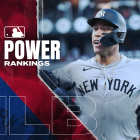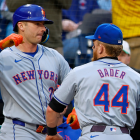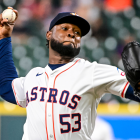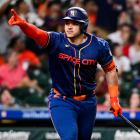
Although there are only two weeks remaining in Major League Baseball's regular season, the expanded playoff format means nearly every team has a shot at making the postseason. "Nearly" is the key term there, as a handful of teams are exceptions. According to SportsLine's forecasts, six teams entered Saturday with less than a 1 percent shot at playing in October: the Boston Red Sox, Kansas City Royals, Los Angeles Angels, and Texas Rangers in the American League, and the Pittsburgh Pirates and Arizona Diamondbacks in the National League.
Fans of those six teams might ask themselves: if the postseason is out of reach, then why should we pay attention to the final fortnight? It's a fair question, and one that provides for a nifty content opportunity.
Below, you'll find our best sales pitch for watching those six teams.
Arizona Diamondbacks
You have to tune in whenever Zac Gallen is on the bump. He's completed a meteoric rise over the past year-plus, ascending from a back-of-the-rotation prospect to a genuine Cy Young Award candidate. (League insiders credit an altered fastball spin axis for his improvement.) Diamondbacks general manager Mike Hazen gambled on Gallen's breakout being real after seven big-league starts, and that bet has paid off. Dating back to the start of 2019, Gallen has the third-highest ERA+ among starters, behind Jacob deGrom and Justin Verlander.
We could try to sell you on watching the rest of the Diamondbacks' veteran starters -- Madison Bumgarner, Luke Weaver, and Caleb Smith -- to see if they can end the season on a better note, but we're going to use this space instead to alert you to rookie Daulton Varsho.
Varsho has one of the most interesting profiles in the sport, in that he's a competent catcher who has been blessed with enough footspeed to play center. The D-Backs have had him play both over his first 25 games, and he could make history if they maintain that approach in 2021. That's because Varsho would become just the third player since World War II to appear in 20 games at both positions in a season, joining Eli Marrero (2002) and Craig Biggio (1990).
Although Varsho's batting line doesn't show it (he's hit .153/.242/.322 in 66 trips to the plate), there's juice in his bat, too. There's a non-zero chance he becomes a prototype for the next era of positional versatility, so we encourage you to get in on the ground floor.
Boston Red Sox
There are two groups worth checking out in Boston: their mid-20 hitters (comprising Alex Verdugo, Bobby Dalbec, Michael Chavis, and Yairo Munoz) and their rotating cast of bullpen characters. The former is clearly -- clearly -- more promising, but we're opting for the latter; it's always interesting to observe who a rebuilding team gives chances to, particularly in the bullpen, where they might try to tap into some inefficiency to unearth a long-term fixture or two.
Have the Red Sox succeeded in doing that? Not so much so far.
Phillips Valdez, a 28-year-old stringbean right-hander pitching for his sixth organization, has been Chaim Bloom's biggest "hit." Valdez has a 2.84 ERA and 2.00 strikeout-to-walk ratio in 25 innings to date. He throws from a low three-quarters slot and is essentially a half-and-half pitcher: half changeups, half sinkers. He doesn't have good command, and it's hard to see him keeping this up for much longer, but he's been very effective at suppressing quality-of-contact.
Boston has three other relievers we figured we'd highlight here -- not because they're good, but because there's an interesting ingredient or two for the coaching staff to play around with.
Robert Stock, 30, was at one point a well-regarded amateur catching prospect. He's long since transitioned to pitching, where he had some success a few years back with the San Diego Padres. Stock can still bring the heat, but his command problems limit his effectiveness.
Robinson Leyer, 27, actually predates Bloom's arrival. He signed with the Red Sox in June 2019, and that transaction tells you a fair amount about how he's held around the league. He has a fast farm and a slider that has generated nearly 50 percent whiffs in a small sample. He's also wild, and has walked seven of the 29 batters he's faced in the big leagues.
Domingo Tapia, 29, has also been part of the organization since 2019. He's a stocky right-hander with triple-digits arm strength. Tapia had a 5.18 ERA and a 1.63 strikeout-to-walk ratio in Triple-A last season, so it's fair to write that he's a longshot to stick around.
Still, if you churn and tweak enough, then you'll eventually run into unexpected contributors.
Kansas City Royals
It might be hard to believe that a team who gave Matt Harvey starts in 2020 has a rotation that includes three promising youngsters, but these Royals did and these Royals do. Right-handers Brad Keller and Brady Singer and left-hander Kris Bubic, each in their age-24 season or younger, have combined to throw 123 innings over 23 starts. In those games, they've posted a 4.02 ERA and have recorded more than 2.30 times as many strikeouts as walks.
Keller's grounder-heavy attack is nothing new. Singer and Bubic are genuine rookies with sticking power, however, so let's give them each a paragraph for their efforts.
Singer, who nearly no-hit Cleveland earlier this week, is essentially a two-pitch pitcher: low-to-mid-90s fastball and a slider that has been his best pitch this season. He receives high marks for his competitive nature, but scouts have long been concerned that he doesn't have good enough stuff to be more than a back-end starter. The development of his changeup, a pitch he's thrown about six percent of the time, will go a long way in dictating that.
The weakest part of Bubic's arsenal is his low-90s fastball, while the strongest parts of his arsenal are his above-average changeup and curveball. Nonetheless, he's throwing the fastball more than half the time this season. The scouting reports and the individual pitch results suggest he should consider leaning into his secondaries more frequently: opponents have hit .307 on the heat, as opposed to .239 against the change and .222 on the breaking ball.
Los Angeles Angels
The Angels have two of the best players in the game (Mike Trout and Anthony Rendon); they have arguably the best defensive shortstop in the league (Andrelton Simmons); they have two promising, albeit struggling youngsters (Shohei Ohtani and Jo Adell); and they have some decent starting pitchers (Dylan Bundy, Andrew Heaney, Griffin Canning, and Jaime Barria). That should be enough for folks to tune in, if only to ask: why isn't this team any good?
Shy of that, we're fans of Joe Maddon's recent Matt Thaiss-as-Zobrist experiment. The Angels started him at second base and in left field this week, both professional firsts, in an attempt to find a more permanent spot in the lineup. Thaiss isn't particularly mobile or graceful (and even a novice could detect his wheels were spinning on some routine plays), but his speed-over-distance numbers are similar to Mike Moustakas', suggesting maybe he has just enough short-term quickness to make it work at the keystone. At minimum, the Angels need to figure out whether or not he's going to hit enough to be worth the headache. Thaiss, who has a good eye and raw power, made some recent alterations to his stance that could help.
Pittsburgh Pirates
The left side of Pittsburgh's infield is worth checking out now that Erik Gonzalez and Ke'Bryan Hayes are the starters there. We're legally prohibited from advising anyone to tune in when the Pirates are hitting, which means our focus here will be on right-hander J.T. Brubaker.
Brubaker has a 5.34 ERA in 30 innings thanks to a disaster start against the Chicago White Sox that saw him yield seven runs in five frames. Prior to that outing, he had been transitioning from making three-inning starts to longer starts. It's unclear if the Pirates will treat him like a conventional starter in '21, but there is stuff to like here, statistically and scouting-wise.
Brubaker's strikeout-minus-walk percentage (14 percent) is in the same neighborhood as a number of more notable pitchers. We're talking Julio Urias, German Marquez, Justus Sheffield, Mike Clevinger, Zack Wheeler, and Max Fried. Not a bad group. His exit velocity against, meanwhile, is in the 67th percentile, suggesting he's suppressing hard contact.
From a scouting perspective, Brubaker leans on his upper-80s slider/cutter. It's his best bat-misser, and opponents have hit just .220 against it despite being his primary offering. He also has a low-to-mid-90s fastball, a high-spin curveball, and a seldom used changeup. Brubaker, predictably, has struggled to tame left-handed hitters (.297/.392/.422).
Brubaker's ultimate role is to be determined. There are a few paths he could take heading forward. He could be used as a traditional back-end starter, of course, but he could be deployed in a more creative manner in the name of avoiding overexposure. That could entail being limited to two times through the order, or it could mean pairing him with a left-handed opener (to bait the opposition into starting more right-handed batters). Maybe the Pirates decide to use him as a multi-inning reliever who can spam opponents with his breaking balls for two or three innings.
Whatever the case, Brubaker is a legitimate big-league arm.
Texas Rangers
You should take this opportunity to become accustomed to seeing Globe Life Field on the television, because it's one of the ballparks you'll be seeing throughout the postseason. Beyond that, the Rangers do have some interesting players -- and not just Lance Lynn and Joey Gallo. Allow us to sing the praises of a handful of Rangers who are worth monitoring.
The Rangers are still trying to find a position for Professional Hitter Nick Solak, who has been splitting time between left field and second base lately after seeing action in center earlier this year. He is, as the title suggests, a capable batsman. He entered Saturday hitting .268/.326/.363 (90 OPS+) with 11 extra-base hits and four stolen bases. Solak hits the ball hard (his 90.6 mph exit velocity is two ticks above the league-standard) and he seldom swings and misses at strikes, resulting in a zone-contact rate north of 90 percent. Six other hitters have similar exit velocities and contact rates -- Anthony Rendon, DJ LeMahieu, Will Smith, Yuli Gurriel, Robinson Cano, and Mookie Betts -- and they all have OPS+ above 100, with half of them having OPS+ over 150. That suggests, on some basic level, that Solak's raw line is an underperformance.
Elsewhere, the Rangers have three position players trying to earn their spot on next year's roster. Catcher Jose Trevino is hitting the ball hard consistently and is tolerable behind the dish; outfielder Leody Taveras can go get it in center field and he has an idea of what he's doing at the plate; and third baseman Isiah Kiner-Falefa can put a ball on the bat and he might be the most underrated defender in the league. He's rangy and athletic with enough arm for the left side. That's a good thing, seeing as how he's probably Texas' best option at short and third:
We'll end with Jonathan Hernandez, who hasn't received the same press as some other rookie relievers -- be it Josh Staumont, James Karinchak, or Devin Williams -- but is nonetheless having a quality freshman campaign. In 20 appearances, he's accumulated a 2.66 ERA while 1) striking out more than a batter per inning, and 2) recording five times as many K's as walks. Hernandez has a 97 mph fastball and a swing-and-miss slider that has coerced a whiff on nearly half the swings against it. He's going to end up closing games for someone, and soon.

































